Alexander Scheinker
Adaptive conditional latent diffusion maps beam loss to 2D phase space projections
Feb 25, 2025Abstract:Beam loss (BLM) and beam current monitors (BCM) are ubiquitous at particle accelerator around the world. These simple devices provide non-invasive high level beam measurements, but give no insight into the detailed 6D (x,y,z,px,py,pz) beam phase space distributions or dynamics. We show that generative conditional latent diffusion models can learn intricate patterns to map waveforms of tens of BLMs or BCMs along an accelerator to detailed 2D projections of a charged particle beam's 6D phase space density. This transformational method can be used at any particle accelerator to transform simple non-invasive devices into detailed beam phase space diagnostics. We demonstrate this concept via multi-particle simulations of the high intensity beam in the kilometer-long LANSCE linear proton accelerator.
Physics-Informed Super-Resolution Diffusion for 6D Phase Space Diagnostics
Jan 08, 2025Abstract:Adaptive physics-informed super-resolution diffusion is developed for non-invasive virtual diagnostics of the 6D phase space density of charged particle beams. An adaptive variational autoencoder (VAE) embeds initial beam condition images and scalar measurements to a low-dimensional latent space from which a 326 pixel 6D tensor representation of the beam's 6D phase space density is generated. Projecting from a 6D tensor generates physically consistent 2D projections. Physics-guided super-resolution diffusion transforms low-resolution images of the 6D density to high resolution 256x256 pixel images. Un-supervised adaptive latent space tuning enables tracking of time-varying beams without knowledge of time-varying initial conditions. The method is demonstrated with experimental data and multi-particle simulations at the HiRES UED. The general approach is applicable to a wide range of complex dynamic systems evolving in high-dimensional phase space. The method is shown to be robust to distribution shift without re-training.
CBOL-Tuner: Classifier-pruned Bayesian optimization to explore temporally structured latent spaces for particle accelerator tuning
Dec 02, 2024



Abstract:Complex dynamical systems, such as particle accelerators, often require complicated and time-consuming tuning procedures for optimal performance. It may also be required that these procedures estimate the optimal system parameters, which govern the dynamics of a spatiotemporal beam -- this can be a high-dimensional optimization problem. To address this, we propose a Classifier-pruned Bayesian Optimization-based Latent space Tuner (CBOL-Tuner), a framework for efficient exploration within a temporally-structured latent space. The CBOL-Tuner integrates a convolutional variational autoencoder (CVAE) for latent space representation, a long short-term memory (LSTM) network for temporal dynamics, a dense neural network (DNN) for parameter estimation, and a classifier-pruned Bayesian optimizer (C-BO) to adaptively search and filter the latent space for optimal solutions. CBOL-Tuner demonstrates superior performance in identifying multiple optimal settings and outperforms alternative global optimization methods.
Time-inversion of spatiotemporal beam dynamics using uncertainty-aware latent evolution reversal
Aug 14, 2024



Abstract:Charged particle dynamics under the influence of electromagnetic fields is a challenging spatiotemporal problem. Many high performance physics-based simulators for predicting behavior in a charged particle beam are computationally expensive, limiting their utility for solving inverse problems online. The problem of estimating upstream six-dimensional phase space given downstream measurements of charged particles in an accelerator is an inverse problem of growing importance. This paper introduces a reverse Latent Evolution Model (rLEM) designed for temporal inversion of forward beam dynamics. In this two-step self-supervised deep learning framework, we utilize a Conditional Variational Autoencoder (CVAE) to project 6D phase space projections of a charged particle beam into a lower-dimensional latent distribution. Subsequently, we autoregressively learn the inverse temporal dynamics in the latent space using a Long Short-Term Memory (LSTM) network. The coupled CVAE-LSTM framework can predict 6D phase space projections across all upstream accelerating sections based on single or multiple downstream phase space measurements as inputs. The proposed model also captures the aleatoric uncertainty of the high-dimensional input data within the latent space. This uncertainty, which reflects potential uncertain measurements at a given module, is propagated through the LSTM to estimate uncertainty bounds for all upstream predictions, demonstrating the robustness of the LSTM against in-distribution variations in the input data.
A conditional latent autoregressive recurrent model for generation and forecasting of beam dynamics in particle accelerators
Mar 19, 2024Abstract:Particle accelerators are complex systems that focus, guide, and accelerate intense charged particle beams to high energy. Beam diagnostics present a challenging problem due to limited non-destructive measurements, computationally demanding simulations, and inherent uncertainties in the system. We propose a two-step unsupervised deep learning framework named as Conditional Latent Autoregressive Recurrent Model (CLARM) for learning the spatiotemporal dynamics of charged particles in accelerators. CLARM consists of a Conditional Variational Autoencoder (CVAE) transforming six-dimensional phase space into a lower-dimensional latent distribution and a Long Short-Term Memory (LSTM) network capturing temporal dynamics in an autoregressive manner. The CLARM can generate projections at various accelerator modules by sampling and decoding the latent space representation. The model also forecasts future states (downstream locations) of charged particles from past states (upstream locations). The results demonstrate that the generative and forecasting ability of the proposed approach is promising when tested against a variety of evaluation metrics.
Physics-constrained 3D Convolutional Neural Networks for Electrodynamics
Jan 31, 2023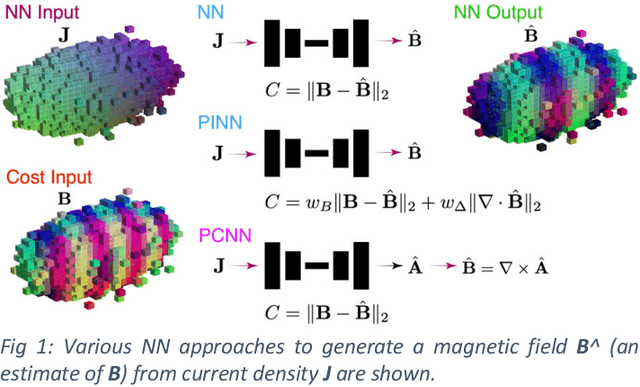


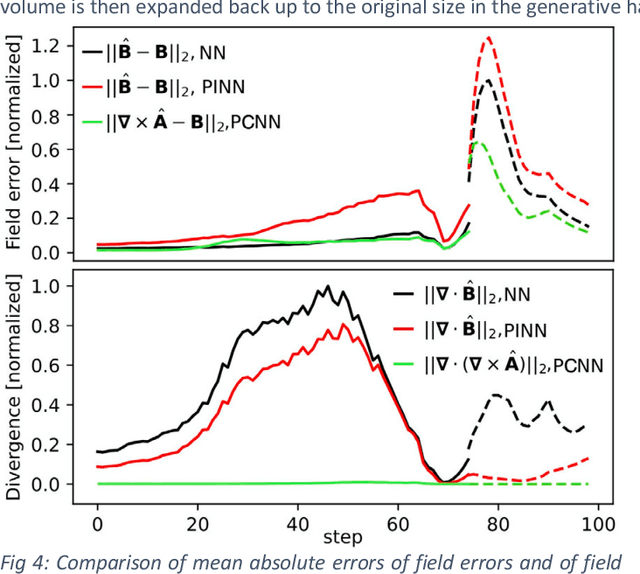
Abstract:We present a physics-constrained neural network (PCNN) approach to solving Maxwell's equations for the electromagnetic fields of intense relativistic charged particle beams. We create a 3D convolutional PCNN to map time-varying current and charge densities J(r,t) and p(r,t) to vector and scalar potentials A(r,t) and V(r,t) from which we generate electromagnetic fields according to Maxwell's equations: B=curl(A), E=-div(V)-dA/dt. Our PCNNs satisfy hard constraints, such as div(B)=0, by construction. Soft constraints push A and V towards satisfying the Lorenz gauge.
Artificial Intelligence and Machine Learning in Nuclear Physics
Dec 04, 2021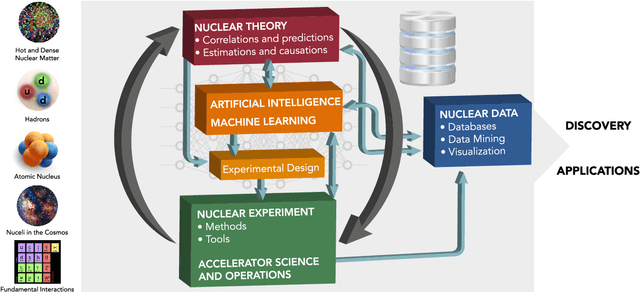
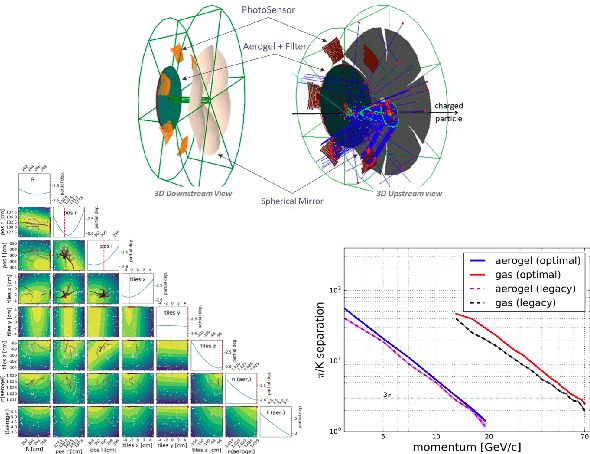
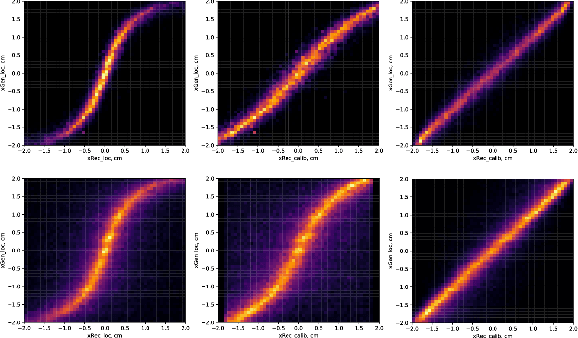
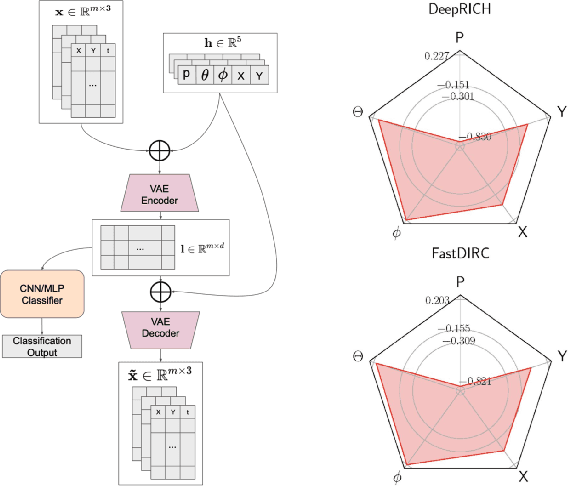
Abstract:Advances in artificial intelligence/machine learning methods provide tools that have broad applicability in scientific research. These techniques are being applied across the diversity of nuclear physics research topics, leading to advances that will facilitate scientific discoveries and societal applications. This Review gives a snapshot of nuclear physics research which has been transformed by artificial intelligence and machine learning techniques.
Adaptive Machine Learning for Time-Varying Systems: Low Dimensional Latent Space Tuning
Jul 13, 2021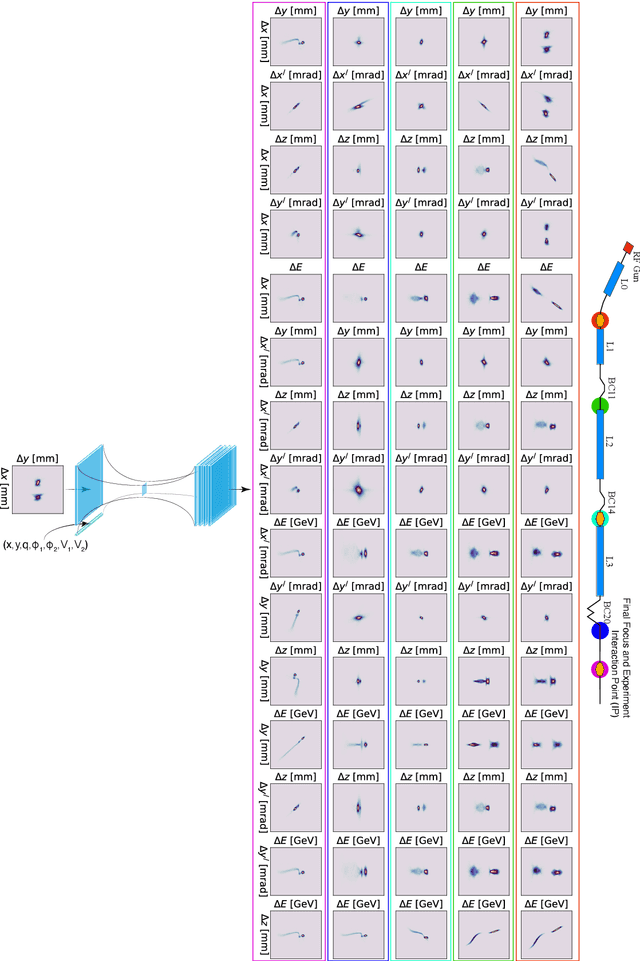
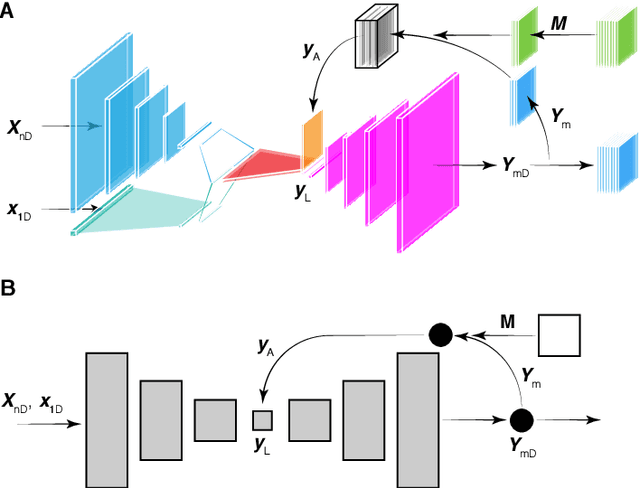

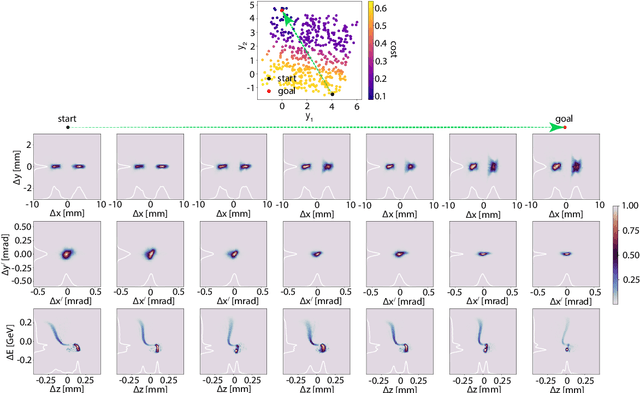
Abstract:Machine learning (ML) tools such as encoder-decoder convolutional neural networks (CNN) can represent incredibly complex nonlinear functions which map between combinations of images and scalars. For example, CNNs can be used to map combinations of accelerator parameters and images which are 2D projections of the 6D phase space distributions of charged particle beams as they are transported between various particle accelerator locations. Despite their strengths, applying ML to time-varying systems, or systems with shifting distributions, is an open problem, especially for large systems for which collecting new data for re-training is impractical or interrupts operations. Particle accelerators are one example of large time-varying systems for which collecting detailed training data requires lengthy dedicated beam measurements which may no longer be available during regular operations. We present a recently developed method of adaptive ML for time-varying systems. Our approach is to map very high (N>100k) dimensional inputs (a combination of scalar parameters and images) into the low dimensional (N~2) latent space at the output of the encoder section of an encoder-decoder CNN. We then actively tune the low dimensional latent space-based representation of complex system dynamics by the addition of an adaptively tuned feedback vector directly before the decoder sections builds back up to our image-based high-dimensional phase space density representations. This method allows us to learn correlations within and to quickly tune the characteristics of incredibly high parameter systems and to track their evolution in real time based on feedback without massive new data sets for re-training.
Adaptive Latent Space Tuning for Non-Stationary Distributions
Jun 06, 2021



Abstract:Powerful deep learning tools, such as convolutional neural networks (CNN), are able to learn the input-output relationships of large complicated systems directly from data. Encoder-decoder deep CNNs are able to extract features directly from images, mix them with scalar inputs within a general low-dimensional latent space, and then generate new complex 2D outputs which represent complex physical phenomenon. One important challenge faced by deep learning methods is large non-stationary systems whose characteristics change quickly with time for which re-training is not feasible. In this paper we present a method for adaptive tuning of the low-dimensional latent space of deep encoder-decoder style CNNs based on real-time feedback to quickly compensate for unknown and fast distribution shifts. We demonstrate our approach for predicting the properties of a time-varying charged particle beam in a particle accelerator whose components (accelerating electric fields and focusing magnetic fields) are also quickly changing with time.
 Add to Chrome
Add to Chrome Add to Firefox
Add to Firefox Add to Edge
Add to Edge